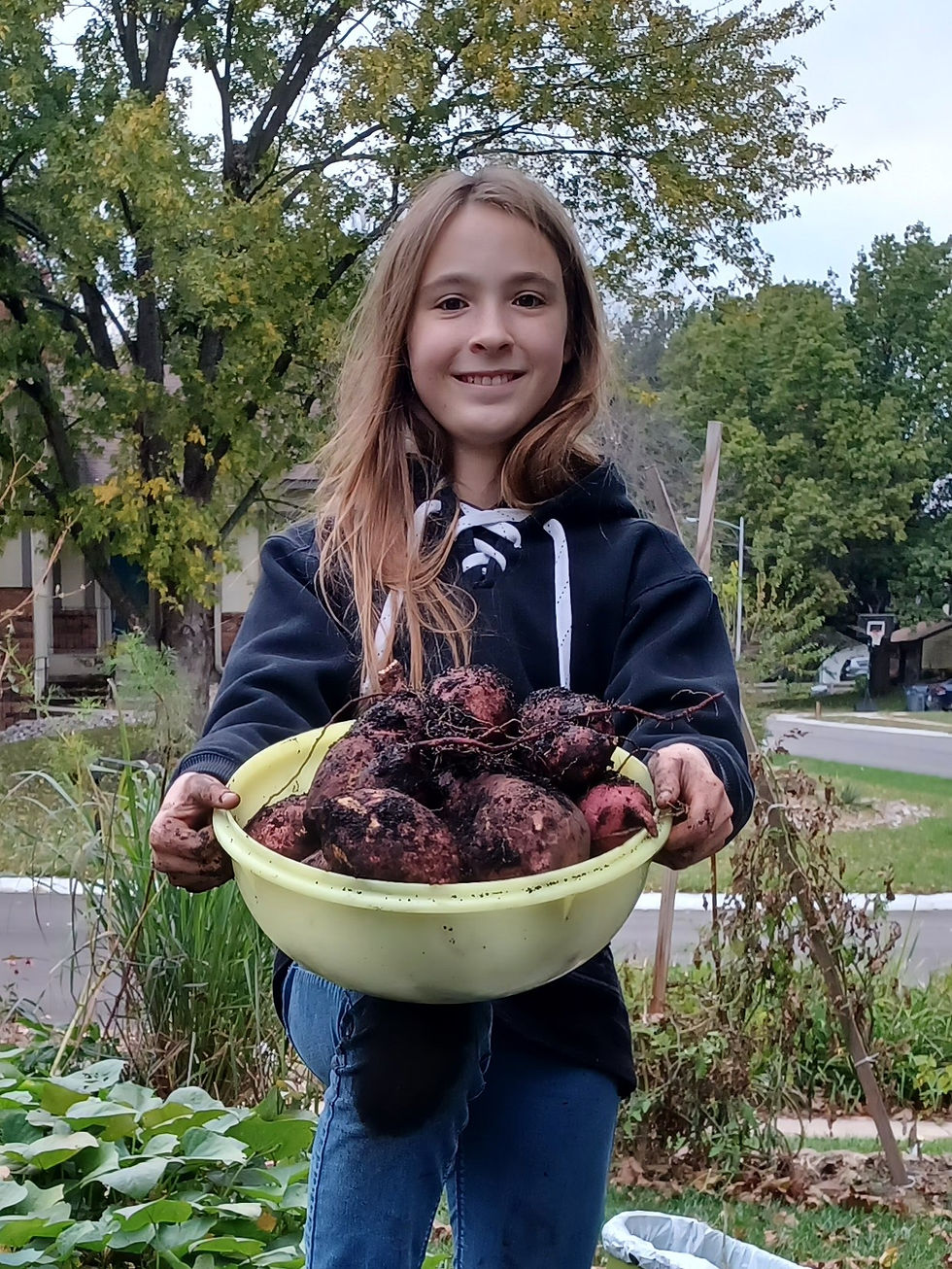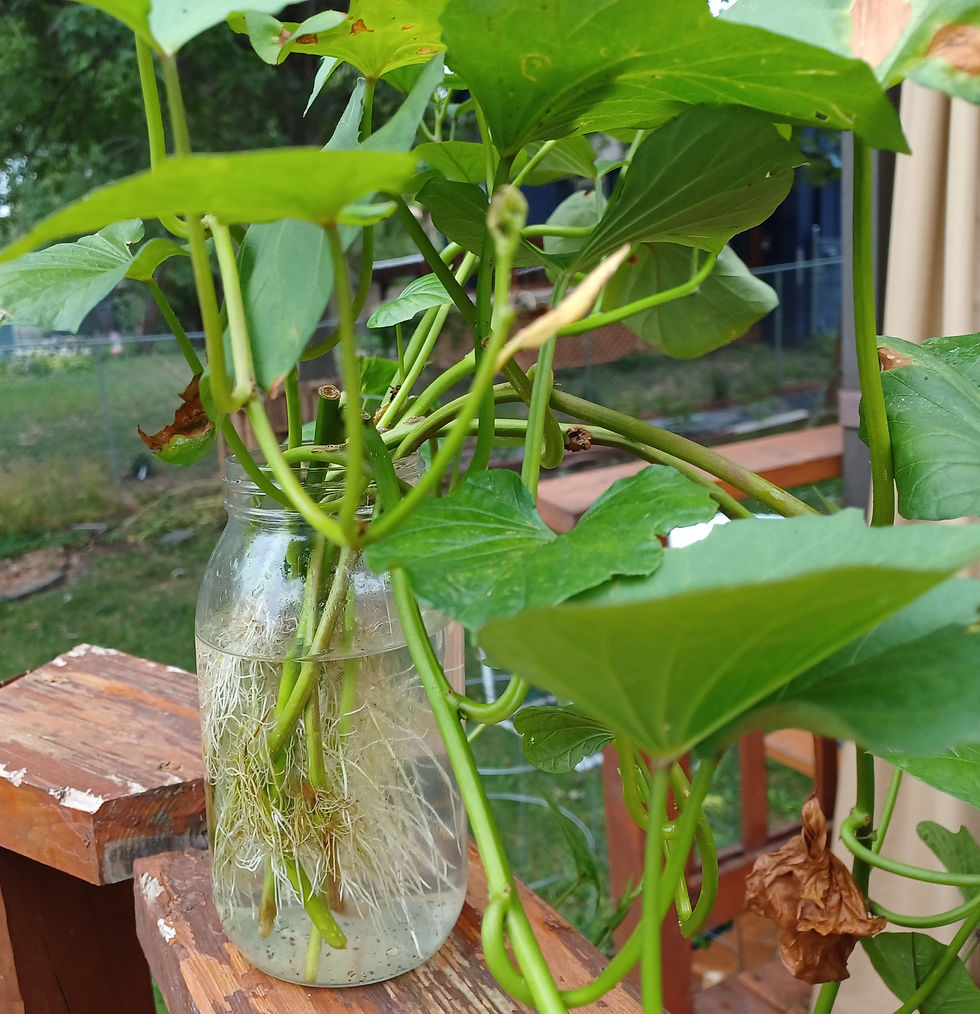Sassy, Succulent, Sweet Potatoes
- Dawn Bly

- Sep 22, 2022
- 5 min read
Updated: Sep 24, 2022
They are not just for the Thanksgiving buffet, but for year-round use at this urban u-pick flower farm in Olathe, KS.

My Dear Lovely Assistant—
One of our favorite vegetables to eat as a family is the sweet potato. Yum! Several years ago while searching for a veggie to keep some ground busy/productive where we had just harvested garlic, I ran across the sweet potato. It has been in our veggie wheelhouse ever since.
Descriptions of the varieties available and how to grow them abound elsewhere. You can start them from sprouted chunks of a base sweet potato or just from a portion of the vine that has started to grow roots. (This is called a slip.) We grow Georgia Red because it was simply the one variety we could get slips for the first year that we needed to purchase them. We also grow another “gift slip” variety...not sure quite what it is, but it works for us. We will focus on the few little twists in usage and growing that we have found works well for us here in suburban Kansas City.
We have more uses for this delectable guy in addition to placeholding in our garden until the cool/winter crops are planted out. Consider:
Tip #1 - It can be decorative!
The vines are useful for us at a time when I have difficulty getting other vines to look great and perform well in arrangements. Vine tips will hold their shape as they poke up above the remainder of the flowers. I made a little video on how to select and cut the vine for use in arrangements here.
Tip #2 - Munch on it!
Do not forget that what grows above ground is just as edible as what grows below ground.
Tip #3 - Reuse the vines!
When the flower arrangements are done, keep the sweet potato vines. If they have not already done so, they will eventually root in water.

The slips will appreciate it if you give them as much sunlight as you can manage, and also if you top off the water every day or so. This is a high-water usage plant. We have found that when the roots have grown long enough for you, you may:
A. Float the root end in your fish tank for a day or so. Our goldfish LOVE to enjoy a marine root salad snack, and it is entertaining to watch them remove and devour the plant material. Once the roots are gone, insert the slip back into water to rest and regrow more roots for your fish or for another purpose.

B. Place in dirt and start another indoor or outdoor plant.
C. Save enough slips and keep them going over the winter. (I plan to keep about 50 going this year.) Some will not survive, but if you keep a nurturing eye on them, others should. Survivors may be planted out when warm weather returns, and you will not need to spend money to purchase slips (have you seen the prices?!).
Tip #4 - Rotate it!
One of our favorite rotation combinations for a patch of ground in a year is to plant garlic followed by sweet potatoes. The timing of when to harvest garlic (start of warm season) is perfect for when to plant the sweet potato (must be warm earth and air). The timing of when to plant garlic (early November, cold) is perfect for when to harvest the sweet potato (in Kansas City, we need to get it out of the ground and cured before freezing weather sets in).
Tip #5 - Protect it!
Humans are not the only ones that enjoy eating young sweet potato greens. Protect your developing vines from your vegetarian/omnivore sweet-potato-loving local fauna (think hungry squirrels and rabbits) until the plants are big enough to fend for themselves. We have a couple of frustrating incidents each year. See item 3C above and budget to lose a certain amount to the local fauna as well as to expect to lose some over the winter.
Tip #6 - Keep them warm and sunny!
If the weather is warm enough, slips that are rooting in water may remain outside to get the best and most sunlight possible. When indoors, place in your sunniest window and consider providing additional artificial light to supplement.
Just like ornamental sweet potatoes, the edible ones will perform beautifully anywhere there is sun and warmth and water. The more warmth and sunlight, the better, even (and especially) on a baking hot, non-shaded driveway where little else survives, these do for us.
Tip #7 - Remove the flowers!
To increase your tuber yield, do not allow the flowers (here in the Kansas City area, ours start to flower in early September) to remain on the plant. The flowers not only do not last in flower arrangements but also divert the plant’s energy from making large, yummy tubers.
Tip #8 - Imprison it!
Forget direct planting slips in the ground unless it is a necessity. In our personal trials on our property, we harvested twice the poundage of edible tubers from planting in large containers using compost versus planting in-ground in compost on top of regular soil. Sweet potatoes seem to grow DOWN as the season progresses, not UP as main season regular white potatoes do, so our clayey, compacted soil inhibits the natural downward growth. Dig deep to harvest the roots, and if growing in a container, make sure to tip the container over to check underneath for harvestable small tubers below. We often have the sweet potato roots virtually fill the container with the sweeties, then the roots travel through the bottom drainage holes to create even more sweet spuds below. They are not the largest of tubers, but they are still useful in their own way.
Any large tub or container with good drainage should do, and if the container is already damaged with cracks or holes in the bottom, and free, I am even more pleased. I prefer not to spend money on a container that I am just going to ruin with too much dirt in it and too much sun on it as well as potentially breaking it when digging out the mature tubers. While on a bike ride or walk, I keep an eye out the day before the neighborhood weekly trash pickup for usable empty containers. (Yes, my husband just loves it when I bat my eyelashes at him and ask him to help me drag home an item.)

Tip #9 - Hydrate it!
Make sure you give these water pigs adequate moisture. Crunchy, small tubers and limp vines are neither tasty nor attractive. When possible, I place the containers or plants close to our house’s foundation and drape a dripline irrigation hose over the plants to allow the dirt around our home’s foundation to benefit from the water runoff. If my clayey soul is kept moist, my home’s foundation will not be as prone to shifting and cracking my walls. Kansas City soil is notorious for its expansion/contraction properties. As long as I have to spend money watering my house's foundation, I might as well get some vegetative benefits.
Have A Happy and Successful Planting Season!
We have found this to be a no-brainer plant for our garden. May you enjoy loads of lovely, sweet spuds in your future gardening endeavors! Have a beautiful day!
.png)





Comments